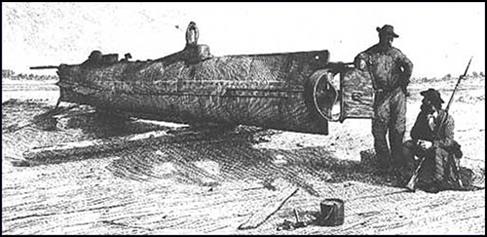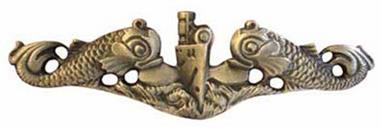foot-long wooden spar, as seen in illustrations made at this time. Mounted on Hunley’s bow, the spar was to be used when the submarine was six foot or more below the surface
The H L Hunley was launched in July 1863. It quickly established a reputation as a dangerous creation. The Hunley was more dangerous to its own crew than to the enemy. That concept was born out of the fact that the Hunley sank three times, twice killing its crew and inventor, the third time it sank while still moored to the dock. The CSS Hunley saw its only action on 17 February 1864.
As planned for the attack, the Hunley did not submerge but instead approached the USS Housatonic on the surface. Lookouts spotted her and opened fire doing no damage. The skipper closed her hatches and the Hunley slipped below the surface leaving only her snorkels above the water to provide the necessary oxygen for the laboring crew. Even with its surprise lost, Hunley continued her attack. She was able to get close enough to lodge the torpedo under her target. The Hunley backed away. The torpedo exploded, sending the Housatonic to the bottom of the bay.
Across the water the observers saw and heard the explosion and cheered wildly as the Housatonic slipped below the waves. Then they waited expectantly for the triumphant return of the Hunley. By morning, the few remaining observers gave up their vigil and went home. The Hunley proved true to her unfortunate reputation.
How and why it sank remained a mystery until 2000. The Hunley’s final resting place was discovered in shallow water on the far side of the bay. Putting to rest the theory that she was sucked inside the Housatonic as she foundered. When the Hunley finally saw daylight again some startling facts were revealed. The entire crew was found sitting peacefully at their stations. Apparently, there was no panic, no frantic effort to escape a sinking vessel that has been found in modern sub-sinking’s. The men simply sat there inexplicably and apparently quietly awaiting their fate. It was a palpable mystery.
The Smithsonian ran some remarkable tests and discovered that the explosion that sank the Housatonic did not damage the Hunley in any way. The explosion did not cause her to sink. It was the shock wave from the explosion that was the culprit. The force of the explosion killed the crew instantly. Without power the Hunley then drifted over the sunken ship and rode along the tide until it came to rest thirty feet from the shore. There it floated until water seeped into the Hunley and pulled her ever so gently to the bottom. Soon she was covered with silt which preserved her in an air free environment thus enabling modern science to finally solve the mystery of what happened to the world’s first successful submarine.
On 17 April 2004, the remains of the crew were laid to rest at Magnolia Cemetery, in Charleston. Thousands of people attended including reenactors and civilians wearing period clothing. Color guards from the U.S. armed forces were in the procession.



